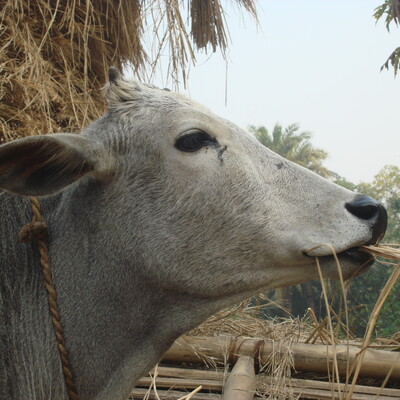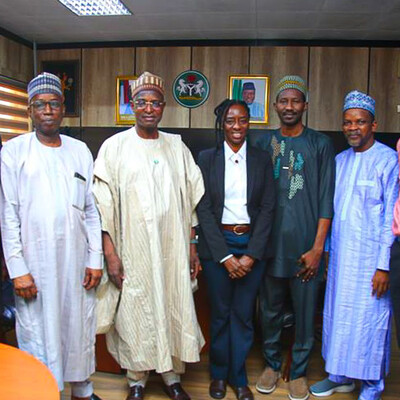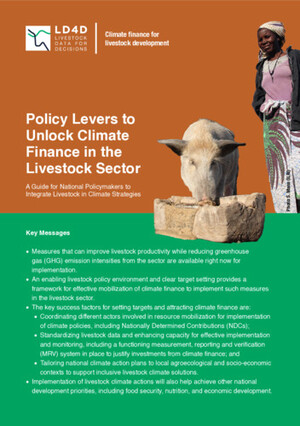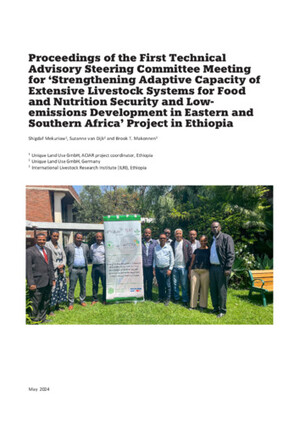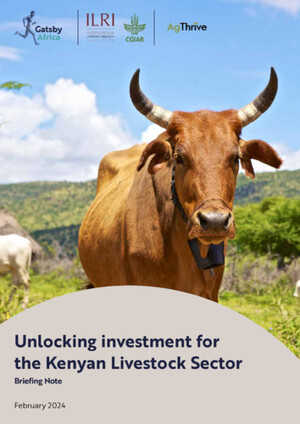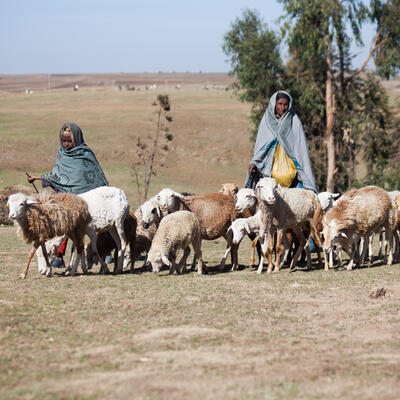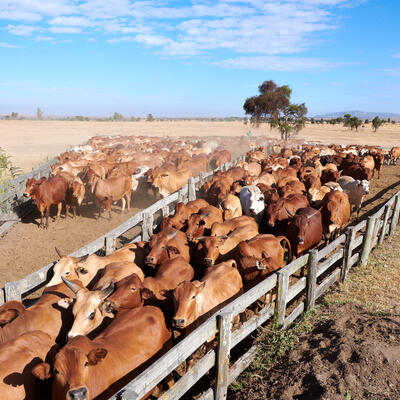
ILRI's Jimmy Smith on the livestock controversies holding back greater use of milk, meat and eggs to nourish the undernourished
Jimmy Smith, director general of the International Livestock Research Institute (ILRI), today gave the keynote speech at a launch of a seminal report from UN Nutrition on Livestock-derived foods and sustainable healthy diets.
What follows is an expanded draft that Smith prepared for the brief talk he gave today.
I’m pleased to participate in today’s launch of this UN Nutrition discussion paper on ‘Livestock-derived foods and sustainable health diets’. This new paper enlightens us about the importance of milk, meat and eggs and presents us with ways to resolve the controversies surrounding the livestock sector in the developed world. These controversies tend to arise from an underappreciation of the diversity of the world’s livestock sector and the many essential roles and functions that livestock continue to fulfil for people, especially those in the developing world.
l like to say that where you stand on an issue is a function of where you sit.
Please allow me to say what I see, from where I sit, about a few of the more contentious livestock issues, which I hope will provide some useful context for today’s launch of this excellent new report from UN Nutrition—the new United Nations inter-agency mechanism for global and national nutrition work.
Of course, anything we say about food is bound to be controversial for some—because what we eat each day touches something individual and personal for every person. And the roles food plays in our lives, of course, extend well beyond eating to include cultural, social, income, risk and other issues.
Today, I want to focus on the essential role of food in nourishing us. I think we are all aware that one can be fed but not nourished. The latest global estimates of poverty and hunger—problems compounded by COVID-19—speak all too-loudly about undernourishment. At least 150 million people are expected to fall into poverty and many, many more have already had their incomes shrink drastically. There are many more hungry people today, with food supplies as well as social events curtailed by the pandemic throughout the world. Among the casualties are the young. Almost 10 million children, for example, are expected to suffer from ‘wasting’—which refers to low weight for height. This pandemic has exacerbated inequalities of all kinds.
What does that mean in relation to livestock-derived foods—milk, meat and eggs—which are the focus of our engagement today? Let me first touch briefly on the uniqueness of these foods, a topic Lora I know will later expound on further.
Livestock-derived foods are nutrient-dense. Consuming even a small amount of meat, or an egg or a dairy product provide humans with significant amounts of key nutrients.
These livestock-derived nutrients also occur in highly ‘bioavailable’ forms—that is, they are packaged in ways that ensure their ready absorption by our bodies. (To get the same amount of iron eating spinach that you get from eating liver, for example, you would have to eat 8 or 9 times more spinach than liver.)
Some of these essential livestock-derived nutrients, such as vitamin B12, are found naturally only in milk, meat and eggs.
For these reasons, foods derived from animals remain essential to the diets of most people, but especially for the most vulnerable groups—for pregnant and lactating women, for infants and children, and for the ill and elderly.
The high density of nutrients in these foods means that the small quantities such groups are able to consume are enough to ensure their wholesome nourishment.
In addition, the nutrients in milk, meat and eggs are essential for the growth and cognitive development of children. There are about 150 million stunted children in the world today (a number likely to increase with the pandemic), something that we know can be addressed and how to address. We know that cognitive impairment that can result from undernutrition causes lifelong harm to both individuals and economies.
Livestock-derived foods—especially when consumed regularly early in life—are powerful means for remedying these ills.
It is a fact that animal-source foods continue to play a critical role in nourishing people and can contribute even more to our diets and health, particularly in developing countries, as populations there grow over this century. The paper being launched today presents the evidence, and makes a compelling case, for this.
What often stands in the way of making better use of milk, meat and eggs for human nourishment are controversies around these foods in the global North. Let me take this opportunity to address some of them.
Livestock and climate change
The first livestock-based controversy that will spring to many people’s minds is around the environmental harms of livestock systems, particularly the greenhouse gases emitted by livestock as they ruminate and by the decomposition of their manure. With the urgent need to stem climate change, the livestock sector, like all sectors contributing to global warming, must work to reduce their emissions of greenhouse gases. Ruminant livestock in particular emit significant levels of greenhouse gases.
The good news is that in the world’s low and middle-income countries, where demand for livestock-derived foods is escalating, there are significant opportunities to reduce the greenhouse gas intensity of livestock systems while at the same time meeting the increased demand for milk, meat and eggs.
Among the millions of smallholder livestock producers, better animal feeding, genetics and health not only improves livestock productivity but also reduces—by at least 30%—the greenhouse gas emissions per kg of milk or meat produced by the livestock. With more milk and meat produced per animal, fewer animals are needed to meet the increasing demand for these products, further mitigating total livestock greenhouse gas emissions.
To meet their Paris climate agreements about reducing their greenhouse gas emissions, countries need accurate metrics for tracking their progress. Specifically, they need reliable estimates of their local emissions rather than, as has been the custom, extrapolating estimates from other regions (the average livestock emissions in North American beef feedlots, for example, will likely differ significantly from those in Kenya’s pastoral systems). In addition, to make fair comparisons of the greenhouse emissions of different sectors, such as livestock and transportation, common life-cycle assessments of their lifetime environmental impacts must be used. These take into consideration all the steps that lead from raw material through manufacture, distribution and usage to final disposal. While this life-cycle assessment has been used to come up with the well-publicized figure of 14.5% for the livestock sector’s total contribution to human-generated greenhouse gases, the same life-cycle assessment has not been used to assess the contributions made by the transport sector, which is assessed at 14%, making livestock an even greater emitter than transport, a ‘fact’ much publicized in Northern media. But a meaningful comparison of the direct greenhouse gas contributions made by the livestock and transport sectors is not 14.5% for livestock versus 14% for transport but rather 5% for livestock versus 14% for transport.
Livestock and land degradation
Earlier this month, ILRI and a group of prestigious environmental partners launched a Rangelands Atlas—a first-ever quantification of the geographical extent of the world’s rangelands. Too dry or cold to be used for crop production, these lands make up more than half (54%) of the Earth’s land surface, and a full 84% of these drylands are used for livestock production.
While in decades past, there was much negative press about overstocking of livestock leading to the desertification of these lands, it is now known that tropical rangelands are degraded mostly by drying climates and the fragmentation of ecosystems by farming and other human interventions rather than by herds of grazing animals.
These ‘livestock lands’ also provide many critical ecosystem services. We know, for example, that well-managed animal herds help to keep carbon stored safely in rangeland soils as well as help to conserve wildlife populations—all the while turning grass and other biomass inedible by humans into nourishing milk and meat.
Livestock and human health
Another major area of controversy around livestock surrounds the damage to human health and to the environment due to many people over-consuming calories, including those of milk, meat and eggs.
A reduction in this over-consumption by the relatively well-off could benefit the health of people and their environments.
But for some two billion undernourished people in lower-income countries, more, not less, consumption of animal-sourced foods is needed.
The ‘livestock debate’ is further fueled of late by the new plant-based or lab-grown products that mimic meat, milk and eggs. While these products may present alternative options among rich populations (and indeed may provoke further debates there regarding their use of GMOs and their own environmental footprints), such choices will not be available or affordable for the world’s poor for decades to come. Their futures depend on maintaining reliable access to conventional milk, meat and eggs derived from animals.
During this pandemic we have heard some calls for closing down the so-called ‘informal’ or ‘wet’ markets of the South (called ‘farmer’s markets in the North), some of which sell live wild as well as domesticated animals, and so may harbour zoonotic pathogens able to pass to humans. But it is from these markets that most people in the South get their food—particularly their meat, which is highly perishable and must be bought freshly slaughtered where there is little refrigeration. Furthermore, there are many practical ways to make these traditional food markets safer and healthier without instituting bans or regulations that would jeopardize millions of lives and livelihoods.
Livestock and life
Finally, there are the stark facts that more than half a billion people rely directly on animals for their very livelihoods and that most of the world’s food is grown on smallholder farms that rely on animals as much as crops.
It is animals, and the manure, cash and traction that they generate, that enables half a billion smallholder farms to produce the staple cereal that provide more than 70% of all food produced in the developing world.
Livestock also serve as vital ‘risk insurance’ to farmers coping with droughts, floods, or market shocks—unlike crops, animals can be quickly moved to safety or sold for cash in emergencies. And they are especially critical to women heading households in rural areas, where few other options exist for earning a regular income and where livestock are among the few productive assets women are allowed to own and manage.
So let me conclude as I started—by saying that where we stand on issues is a function of where we sit. I have attempted here to highlight some of the opportunities as well as controversies around a very diverse livestock sector and the foods it produces.
I hope that my words have allowed you to sit with me for a moment, here in the developing world, among people for whom sustainable livestock development sustains lives and livelihoods as well as environments.
And I ask you to remember that while the health of all people matter—those of us who eat too much as well as those of us who eat too little—there is no moral equivalence between making poor food choices and having no food choices at all.
Thank you for your kind attention.
Header image art by Elena Katsyura.
Related materials
ILRI-World Economic Forum white paper on protein futures
World Economic Forum-ILRI: Meat: the Future series—Options for the Livestock Sector in Developing and Emerging Economies to 2030 and Beyond
Jan 2019
Livestock-enhanced diets in the first 1,000 days of life: Pathways to better futures in low-income countries
19 Jun 2018
Healthy sustainable diets for all: A view from Ethiopia
Op-ed by Gebregziabher Gebreyohannes
Thompson Reuters Foundation News
7 Feb 2019
Anti-livestock rhetoric in wealthy west impacts poor nations
Cornell Alliance for Science
Op-ed by Susan MacMillan
27 Jul 2018
Why milk, meat & eggs can make a big difference to world’s most nutritionally vulnerable people
Op-ed by Silvia Alonso
Inter Press Service News Agency
1 Jun 2018
Lora Iannotti on livestock and animal-source foods at Berlin’s Global Forum for Food and Agriculture
ILRI News blog
6 Mar 2018
ILRI remarks to UN Committee on Food Security commending newly agreed livestock recommendations
Susan MacMillan
ILRI News blog
18 Oct 2016
Veganism is not the key to sustainable development—natural resources are vital
Op-ed by Jimmy Smith
The Guardian
16 Aug 2016
No one dietary choice is the answer to sustainable development—ILRI in ‘The Guardian’
Op-ed by Jimmy Smith
ILRI News blog
17 Aug 2016
The meat we eat, the lives we lift–Opinion by ILRI director general Jimmy Smith
Op-ed by Jimmy Smith
Economist Insights (reprinted in ILRI News blog)
26 Feb 2015
Why animal source foods need to be part of the global food security and nutrition agenda
Slide presentation by Lawrence Haddad (GAIN) at the International Tropical Agriculture Conference, Brisbane, Australia
11−13 Nov 2019
The role of livestock in food and nutrition security
Slide presentation by Jimmy Smith at the University of Florida Global Nutrition Symposium on ‘Nurturing development: Improving Human Nutrition with Animal-Source Foods’
29–30 Mar 2017






